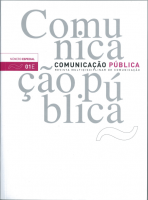Success factors in the advertising against domestic violence
DOI:
https://doi.org/10.4000/cp.202Keywords:
advertising, domestic violence, success factorsAbstract
Advertising is an important weapon in the fight against domestic violence. Thus, we sought to identify factors that may contribute to the success of campaigns against domestic violence. The analysis focused 10 years of campaigns in Portugal and through the indicators, evolution of reporting numbers and the number of news in the media, we distinguished which campaigns were more successful and those that had less success. After extensive analysis of 44 ads, we concluded, for instance, that the segmentation of target audience and realistic representation of signs of violence, when they exist, can be success factors in the campaigns against domestic violence.
Downloads
References
Andreasen, A. R. (1997) Challenges for the science and practice of social marketing. In: Goldberg, M. E., Fishbein, M. & Middlestadt, S. E. eds. Social Marketing: Theoretical and practical perspectives (p. 3-19), Mahwah, Lawrence Erlbaum Associates.
Aparici, R., Matilla, A. G., Santiago, M. V. (2000) La imagen, segunda reimpresión, Madrid, UNED.
Balonas, S. (2006) A Publicidade a Favor de Causas Sociais. Evolução, caracterização e variantes do fenómeno em Portugal. Tese de Mestrado, Universidade do Minho.
Bardin L. (1977) Análise de Conteúdo. Lisboa, Edições 70.
Cardoso, L. M. (2003) A Problemática do Narrador. Da Literatura ao Cinema, Lumina - Juiz de Fora, Facom/UFJF, v. 6 n. 1/2, p. 57-72.
Coffman, J. (2002) Public communication campaign evaluation: An environmental scan of challenges, criticisms, practice, and opportunities. Cambridge, MA, Harvard Family Research Project.
Cook, G. (2001) The Discourse of Advertising, 2.ª edição, Londres, Routledge.
Dourado, A. (s.d.) Do comercial ao social: uma abordagem da publicidade cidadã. Escola Superior de Educação do Instituto Politécnico de Setúbal.
Gonçalves, G. M. P. (2005) A publicidade só é má quando promove coisas más. Livro de Actas — 4º SOPCOM, Universidade da Beira Interior, p. 277-286 [Internet] Disponível em http://www.bocc.ubi.pt/pag/goncalves-gisela-publicidade-so-ma-quando-promove-coisas-mas.pdf [Consult. 4 Fevereiro 2011].
Heller, E. (2009) A Psicologia das Cores, 1.ª ed., Barcelona, Editorial Gustavo Gili.
Hyman, H. H., Sheatsley, P. B. (1947) Some Reasons Why Information Campaigns Fail, Public Opinion Quarterly, vol. 11, p. 412-423.
Kaiser Family Foudation (2001) There's No Excuse for Domestic Violence. Public Service Advertising in a New Media Age.
Kees, J., Burton, S., Tangari, A. H. (2010) The Impact of Regulatory Focus, Temporal Orientation, and Fit on Consumer Responses to Health-Related Advertising. Journal of Advertising, vol. 39, n.º 1, p. 19-34, 16 p.
Kotler, P., Roberto, N., Lee, N., (2002) Social Marketing: improving the quality of life, 2.ª ed., Thousand Oaks, Sage Publications.
Lannon, J. (2008) How public service advertising works. Reino Unido, World Advertising Research Center.
Lipovetsky, G. (2009) A Felicidade Paradoxal ― Ensaio sobre a Sociedade do Hiperconsumo. Lisboa, Edições 70.
Magalhães, F. (2006) A Psicologia do sorriso humano. Porto, Universidade Fernando Pessoa.
Magalhães, F. (2007) A Psicologia das Emoções. O Fascínio do Rosto Humano. Porto, Universidade Fernando Pessoa.
Martín, A. S. (2002) ¡Mírame! Teoría y práctica de los mensages publicitarios. Madrid, Ediciones Eneida SALUD.
McCombs, M., Shaw, D. L. (1973) The Agenda-Setting Function of Mass Media, Public Opinion Quarterly, vol. 37, p. 62-75.
Mendelsohn, H. (1973) Some Reasons Why Information Campaigns Can Succeed, Public Opinion Quarterly, vol. 37, p. 50-61.
Moreno, I. (2003) Narrativa audiovisual publicitaria. Barcelona, Paidós.
Romero, M. V. (2005) Lenguaje Publicitario. Barcelona, Ariel Comunicación.
Saborit, J. (2000) La imagen publicitaria en television. Madrid, Cátedra.
Salmon, C. T., Johnson, L.M. (2001) Communication Campaign Effectiveness: Critical Distinctions. In: Rice, R. E., Atkin, C. K., Public Communications Campaigns, 3.ª ed., Thousand Oaks, Sage Publication.
Schmeling, D. G., Wotring, C. E. (1980) Making Anti-Drug-Abuse Advertising Work, Journal of Advertising Research, vol. 20, n.º 3, p. 33-37, 5 p.
Vecchiato, G., Astolfi, L., Cincotti, F., De Vico F. F., Sorrentino, D. M., Mattia, D., Salinari, S., Bianchi, L., Toppi, J., Aloise, F., Babiloni, F. (2010) Patterns of cortical activity during the observation of Public Service Announcements and commercial advertisings. Nonlinear Biomedical Physics, suplemento 1, vol. 4, p. 1-9.
Veer, E.; Tutty, M., Willemse, J. (2008) It's Time to Quit: Using Advertising to Encourage Smoking Cessation, Journal of Strategic Marketing, vol. 16, n.º 4, p. 315-325, 11 p.
Veríssimo, J. (2008) O Corpo na Publicidade, Lisboa. Edições Colibri/Instituto Politécnico de Lisboa.
Villafañe, J., Mínguez N. (2009), Principios de Teoría General de la Imagen. Madrid, Pirámide.
Walsh, G., Hassan, L. M., Shiu, E., Hastings, G. (2007) Profiling the Target Audience of a Social-Marketing Campaign: A Cluster Analysis Approach. AMA Winter Educators' Conference Proceedings, vol. 18, p. 100-101, 2 p.
Weil, P., Tompakow, R. (2001) O Corpo Fala, a linguagem silenciosa da comunicação não verbal, 53.ª edição, Rio de Janeiro, Editora Vozes.
West, D. C., Sargeant, A. (2004) Taking Risks with Advertising: The Case of the Not-For-Profit Sector. Journal of Marketing Management, vol. 20, n.º 9/10, p. 1027-1045, 19 p.
Wooden, R. (2008) The Advertising Discipline and Social Change. Journal of Advertising Research, p. 10-12.
Outros Documentos
Violência Doméstica 2010 Ocorrências participadas às Forças de Segurança. Direcção-Geral de Administração Interna. [Internet] Disponível em http://www.dgai.mai.gov.pt/cms/files/conteúdos/VD_Relatorio%20Anual_2010_2_5_2011.pdf.
Lei n.º 59/2007. D.R I SÉRIE. 152 (2007-09-04) 6188.
Sítios
Downloads
Published
Issue
Section
License
Copyright (c) 2011 Direitos do Autor (c) 2011

This work is licensed under a Creative Commons Attribution-NonCommercial 4.0 International License.
Os conteúdos da Comunicação Pública estão licenciados com uma licença Creative Commons - Atribuição-NãoComercial 4.0 Internacional.


